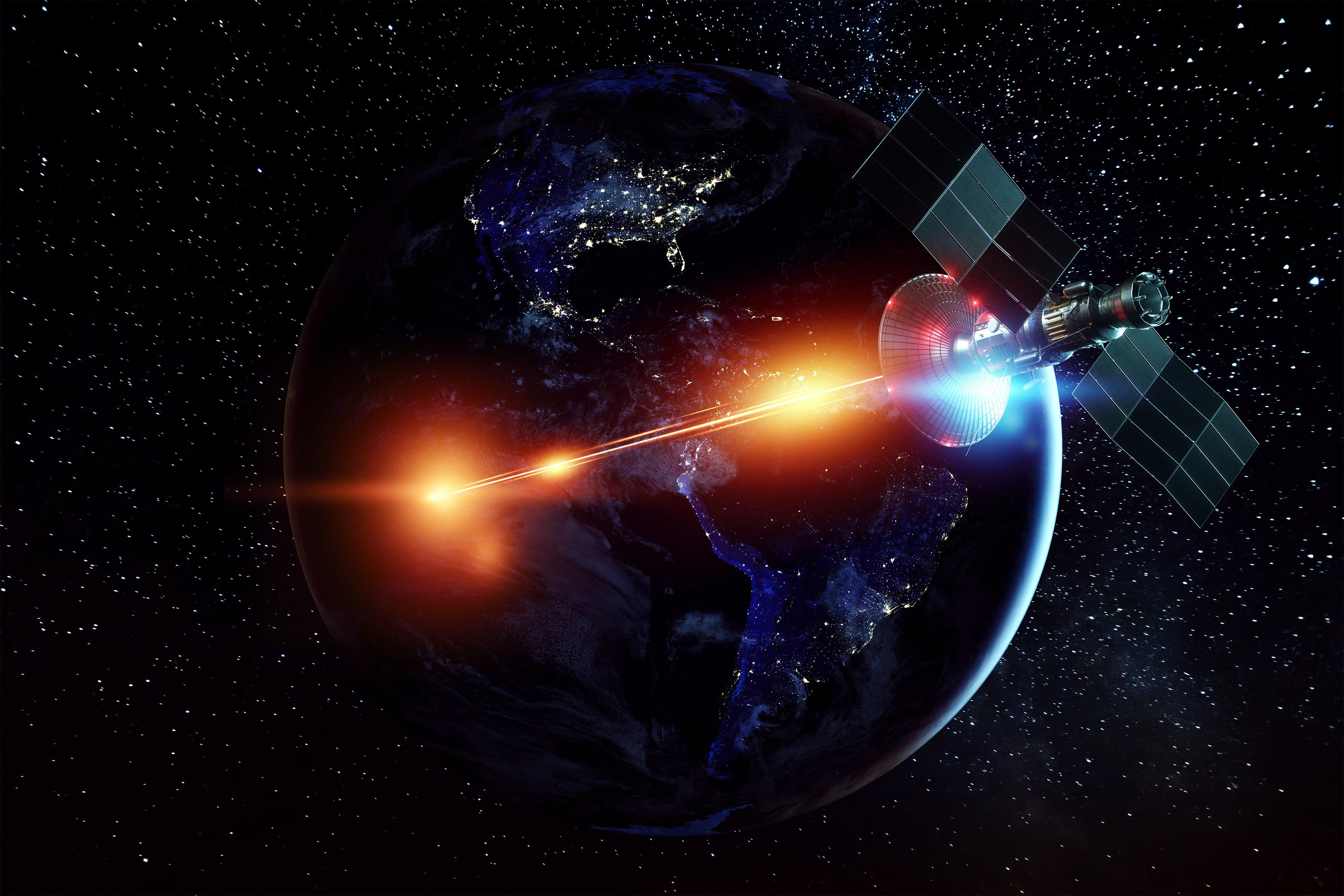Ever since the Biblical character of Cain killed his brother Abel with a rock, the notion that one could hit others with an object to cause harm would forever remain a part of humanity. The objects got bigger, sharper, and with extra propulsion over time, but the concept is still the same.
It uses kinetic energy to damage another human. Which makes the concept known as Rods From God the ultimate form of kinetic weaponry. This theoretical weapon would drop telephone pole sized rods of dense tungsten from a satellite in orbit.
Picking up speed with each passing second, the rod would then penetrate the ground and generate an explosion akin to a small nuclear weapon using nothing but gravity for its propulsion. If this system had actually been created it would have transformed the race for weapons of mass destruction. As it stands, we're left to only seek to understand it in theory.
What is the concept of "Rods from God" kinetic bombardment? How does Project Thor compare to modern kinetic energy weapon systems? Would Rods from God be as devastating as believed in science fiction? How to survive a kinetic energy projectile dropped from space. A Summary Conclusion of Jerry Pournelle’s Big IdeaTable of Contents

Image source: Unsplash_Erwan Hesry
What is the concept of "Rods from God" kinetic bombardment?
The concept is amazingly simple and should be scientifically possible to create. It's just dropping something on someone from very high in the sky. This has been taking place throughout the history of warfare.
During the Vietnam War, Air Force planes would drop what are known as "lazy dog" bombs which were nothing more than small pieces of steel. As such, kinetic weaponry is nothing new. With the onset of space travel, now we just get to drop things from much higher up.
Origins of the Rods from God weapon system and Jerry Pournelle's contribution

Image source: Slashgear
However, the term Rods from God became popularized by a science fiction author and aerospace engineer by the name Jerry Pournelle. He popularized the concept which became known as Project Thor. He envisioned the kinetic weapons dropped from outer space as an alternative to nuclear weapons.
While the impact would release the energy of a small nuclear weapon, there would be no subsequent radiation or fall out. As such, this was not just science fiction to Pournelle. He genuinely pitched the concept to the Pentagon while strategizing about the future of warfare. While he would never get to see Project Thor come to fruition, he at least demonstrated that the concept was possible.
How tungsten rods would function as a kinetic bombardment system
Tungsten was chosen for the project because it is one of the densest naturally occurring metals on the planet. It is 1.7 times denser than led which would mean you could get the most metal possible to hit the strike zone.
Tungsten also has an extremely high melting point of 6,192 degrees Fahrenheit. As falling rod began to reach speeds near Mach 10, the friction with the atmosphere would be intense. It was believed that tungsten had the best chance to hold up under heat over any other kinetic energy projectile.
How does Project Thor compare to modern kinetic energy weapon systems?
Now that you know the basic premise of Project Thor, let's look how it stacks up against other kinetic weapons in the U.S. military arsenal. Currently, multiple branches of the military deploy kinetic weaponry. Perhaps the most talked about project would be the rail gun being developed by the U.S. Navy.
Rather than use gunpowder to launch the projectile or explosives to damage upon contact, the rail gun uses electromagnetic force to send a tungsten round out at speeds over Mach 7.
When impact is made, it is the energy released by the dense round that causes the damage. While they have successfully tested and deployed rail guns about a Navy vessel, concerns over cost integration viability threaten to end the project before mass adoption.
The Air Force's involvement in kinetic bombardment research
Apart from toying around with "lazy dog" bombs in the Vietnam War, the Air Force has primarily entered the kinetic energy game via hypersonic missiles. These missiles that travel beyond Mach 5 are supposed to be extremely difficult to intercept.
The Air Force and newly formed Space Force are also using kinetic weapons as ground based interceptors for incoming missiles or ICBM. No need to load the interceptor up with explosives as the speed of the projectile is enough to take down the incoming threat.
Kinetic Weapons used by Special Operations Forces
Finally, special operators have been deploying kinetic weapons and drones for years now. If there is a high value target in a densely populated area, a kinetic drone is sent in for the kill in order to minimize the collateral damage. They have been used to take out targets in Iraq, Syria, Afghanistan and in places where they can't admit they've been.
Many of these drones were given to Ukraine for use in their ongoing conflict with Russia. Results from the battlefield are mixed when it comes to mass deployment, but their affinity by special operators lets us know that kinetic weapons definitely have a place on the modern battlefield.
Would Rods from God be as devastating as believed in science fiction?

Image source: cdn.i-scmp.com
As Pournelle was popularizing the theory through science fiction work, it is important to note that this is not the most destructive concept to come out of the Cold War. In the 1950s, a theoretical nuclear weapon known as Project Sundial was conceptualized, but never created.
The weapon would explode with the force of 10,000 megatons and would create firestorms the size of entire states. It would lead to nuclear winter and most likely, the end of humanity.
Both the Soviets and U.S. experimented with the idea of encasing a nuclear weapon in Cobalt. The explosion would transform the material from Cobalt-59 to Cobalt 60 which is a highly radioactive material.
Cobalt-60 has a half life of 5.7 years and as such, would litter the world with radioactive fallout for decades. This too was thought to be a weapon that would end humanity, which is why they were never pursued.
Analyzing the kinetic energy equivalent of tungsten cylinder impacting at Mach speeds
It is a light of weapons that could truly end humanity that we must view the destructive power of this project. Tungsten cylinders impacting Mach speeds would indeed devastate a city. However, it wouldn't end humanity or even kill everyone in the city. This was part of Pournelle's advocacy for such a system as there would not be radioactive fallout.
Certainly, multiple cylinders could eliminate a city in the same way multiple nuclear warheads would. The tungsten would also penetrate hundreds of feet into the ground which makes them an ideal weapon for bunker busting. Rather than a true weapon of mass destruction, tungsten dropped from space could be viewed as a more moderate approach than all out nuclear war.
Why was Project Thor Never Put into Action
Despite their lethality and lack of radioactive fallout, the project never moved forward for a few reasons. The first is the cost to send these dense heavy cylinders into space is prohibitive. It would just take too much fuel to orbit them in any numbers significant to be a true deterrent.
There are also logistical trouble in getting satellites into position in enough time for a quick or retaliatory strike. Remember, gravity is the only thing fueling these rods and it is going to fall where you drop it. There is no room for error.
Are kinetic bombardment systems legal under international space law?
The final reason the project was never pursued is that it would be in violation of treaties signed during the Cold War to prevent weapons of mass destruction out of the space race. Most specifically, the Outer Space Treaty of 1967.
With enough destructive force available on the planet to end the world two times over, there was no reason to violate the treaty just to have the chance of a cylinder impacting at Mach 10 in the arsenal.
There was also concern that due to the lack of radiation, there might be a greater chance of a nation using high-velocity kinetic weapons than nuclear weapons.
How to survive a kinetic energy projectile dropped from space.
As with all good science fiction writing, we're going to do our own musing as to how one would survive the devastation from a kinetic orbital strike using tungsten. As with any weapon of mass destruction, if you are at the center ground zero, you're going to have a really bad day.
The rod will hit with the impact energy of 11.5 tons of TNT and there is not much you can do if you are in the blast radius.
The crater size would likely be 100 plus feet deep and 150 feet across. The blast radius would reach out up a half a mile with widows and buildings taking damage up to a mile out.
Fires would likely break out through the area causing firestorms to erupt in a major urban center. The immediate casualties would be between 10,000 to 100,000 immediately depending on the population of the city.
Surviving a tungsten strike is not act of science fiction writing
Due to the lack of radiation, the feasibility of surviving a strike of this kind is high if you are already prepared for the worst. With a nuclear strike, it is advised that those near the blast shelter in place for 48 to 72 hours in order to avoid the worst of the radiation. You don't have that concern here. This means you can immediately begin your evac plan if it is safe to travel.
Civilian infrastructure will be most certainly devastated and waiting around for people to start starving is never the best course of action. It is likely that such a strike with these rods would come with little to no warning.
There is no strategic defense initiative or Star Wars space shield to protect us from a falling chunk of metal. Because you'll have a Geiger counter, you'll be one of the first to realize that this was not a nuke strike. Which means you can be on the move early. The broader assumption by the public will likely be that it was a nuclear weapon and people will shelter in place accordingly.
There also will not be the corresponding EMP that normally comes with a nuke. This means that technological advantages such as cell phones may still be working in some areas. This will give you a chance to start communicating with your loved ones and execute your pre-arranged evac plan.
Practice the plan with precision as often as you and refine it as need be. If you were not at the center of the blast, you can have a chance at survival if you have a plan. Don't wait until the entire city of scared people hurls their worst upon you in the crisis. If you live in a large city that is struck, it is time to get out of town.
A Summary Conclusion of Jerry Pournelle’s Big Idea
While technologically possible, the weapon system envisioned by Pournelle isn't likely to exit the realm of science fiction anytime soon. Perhaps changes in space delivery technology could make it more economically viable in the future, but the political barriers are still in place. It would cause the launch of a new arms race in space and at least with nuclear weapons, the idea of mutually assured destruction keeps other countries from making a strike.
However, survival from this system is possible, depending on the scale with which they are used. Keep training and preparing as if the worst will come true and if Thor ever does rain down is mighty rod upon, you'll be ready.
Frequently Asked Questions
